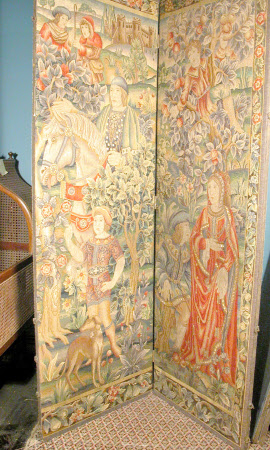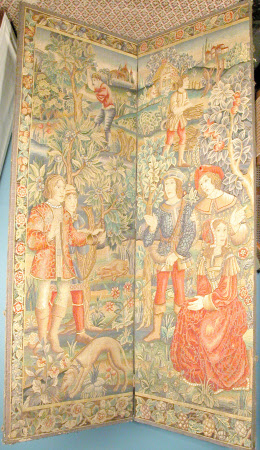Screen with Hunting Scenes
Cambridge Tapestry Company
Category
Textiles
Date
circa 1930 - circa 1939
Materials
Wood, metal, canvas, wool, silk
Measurements
1.97 m (H); 0.66 m (W)
Place of origin
Cambridge
Order this imageCollection
Lanhydrock, Cornwall
NT 883242
Summary
A double-sided two-leaf screen covered with needlework, made by the Cambridge Tapestry Company, c. 1930-1939. The needlework cover to the screen is decorated with figures in Medieval dress in a wooded landscape, hunting and picking fruit. There is a border of vine leaves, fruit and flowers.
Full description
The screen was made by the Cambridge Tapestry Company, a textile and restoration workshop based in Cambridge in the 1920s and 1930s. The design matches a cartoon for a four-leaf screen which is now part of the Witter Collection, owned by descendents of the founders of the Cambridge Tapestry Company. It is illustrated at http://www.thewittercollection.co.uk/. A screen with a similar design, also made by the Company, was described in an account of a needlework exhibition in Sydney in the Sydney Morning Herald in 1938: "another Cambridge tapestry – this one making a fourfold screen – shows a rich old-world restraint in its representation of a hunting scene." (Sydney Morning Herald, 8 June 1938, p. 6). It is not clear whether this was the actual screen now at Lanhydrock, or another piece made after the same cartoon. The Cambridge Tapestry Company began as a cottage industry in Ickleford, Hertforshire, where Mr and Mrs Witter taught needlework and metalworking to local children. Their business expanded and in 1904 they officially established themselves as Ickleford Industries. Some time between 1908 and 1911 the pair became friends with M. Gonnet, a weaver from the Gobelins tapestry workshop in Paris, and he sent two of his weavers to England to teach the art of tapestry weaving and restoration (http://www.thewittercollection.co.uk). The growing trade in historic tapestries led to rapid expansion and in 1916 premises were bought at no. 15 Thompson's Lane, and the Cambridge Tapestry Company was officially established. During the 1920s the restoration business boomed, and there were as many as eighty workers, mainly young women, in each of the two Cambridge workrooms. One of the most famous projects undertaken was the restoration of an early sixteenth-century tapestry of the 'Life of the Virgin' that was subsequently bought by William Burrell and is now in the Burrell Collection. The workshop declined during the 1930s due to lack of business and the difficulty in obtaining raw materials. Much of the workshop's stock was sold to the Royal School of Needlework in 1939, and activity ceased altogether in 1943 (CWN 1988; Cheney 1988). In addition to restoring historic tapestries and textiles, the Cambridge Tapestry Company produced new pieces of needlework, including commissions for items such as banners and heraldic hangings. More artistic pieces were also created for exhibition, for example a full-length Madonna shown at an exhibition at Sunderland House in London in 1936 (The Times, 5 February 1936). A furniture restoration studio was attached to the Cambridge workshop, and restored pieces of furniture would be fitted with new covers made by the needlewomen (examples are illustrated at http://www.thewittercollection.co.uk/). Designs for canvaswork were also produced, mainly at the Ickleford workshop. The Cambridge Tapestry Company is also known to have produced three large-scale tapestries (woven on a loom, as opposed to stitched onto a canvas base like the present needlework screen). Two of these are in the National Trust's collection at Anglesey Abbey: a view of 'Anglesey Abbey' commissioned by Lord Fairhaven in 1934 (no. 516774) and a panel with 'The Arms of Huttleston Rogers Broughton, 1st Lord Fairhaven', commissioned in 1939 (no. 516781). Queen Mary visited the Cambridge workshop during the weaving of the 'Anglesey Abbey' tapestry, and this led to the commission by friends of the King and Queen of the 'Royal Jubilee Tapestry', a view of Windsor Castle with a heraldic border made to celebrate the Silver Jubilee of 1935 (Barber 1936a). (Helen Wyld, 2012)
Provenance
Possibly acquired for Wimpole Hall, Cambridgeshire by Francis Gerald Agar-Robartes, 7th Viscount Clifden, c. 1920s/1930s and brought by him to Lanhydrock;
Makers and roles
Cambridge Tapestry Company , workshop
References
Wyld 2013: Helen Wyld, ‘Unusual Skill and Enterprise: Anglesey Abbey and the Cambridge Tapestry Company’, National Trust Arts, Buildings and Collections Bulletin, May 2013, pp. 1-3 CWN 1988: 'Peerless skills faded away during the war', Cambridge Weekly News, 28 July 1988 Cheney 1988: Judy Cheney, 'The Cambridge Tapestry Company', Cambridge Guild of Weavers Spinners and Dyers Newsletter, 14 January 1988 (n.p.) Cheney 1987: Judy Cheney, 'The Cambridge Tapestry Company', Cambridge Guild of Weavers Spinners and Dyers Newsletter, 13 August 1987 (n.p.) Barber 1937: Clifford Barber, 'A Little Known Cambridge Industry', The Cam, May 1937, pp. 136-8

